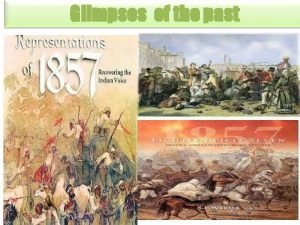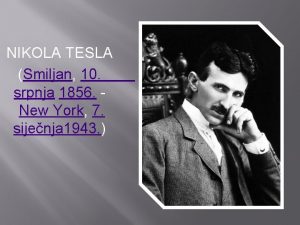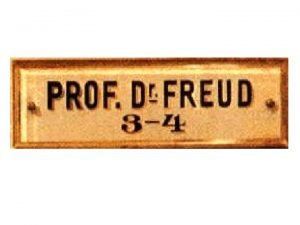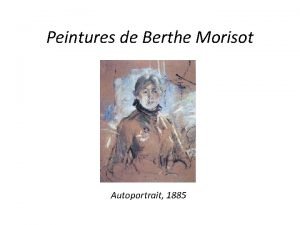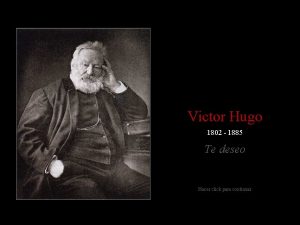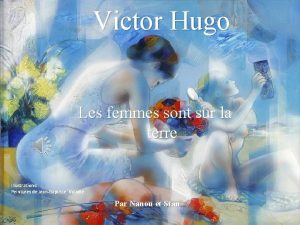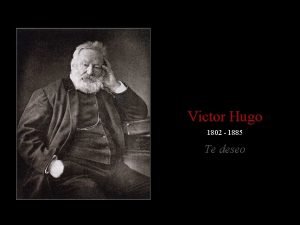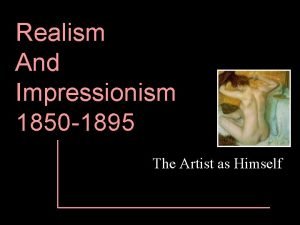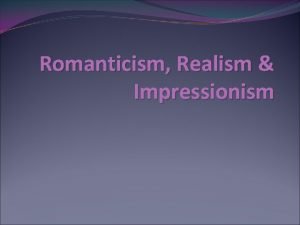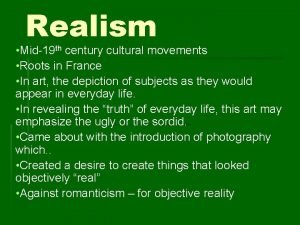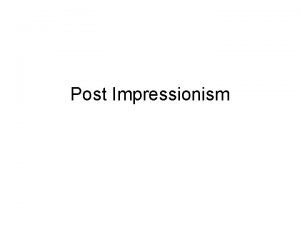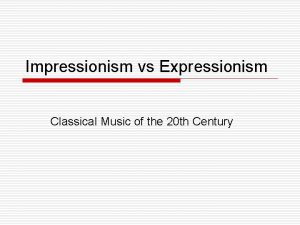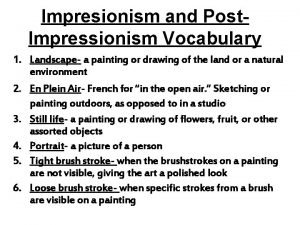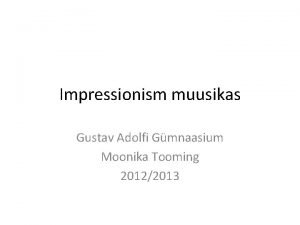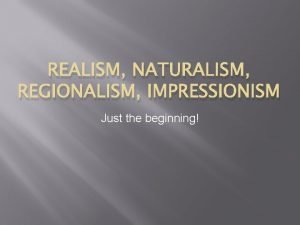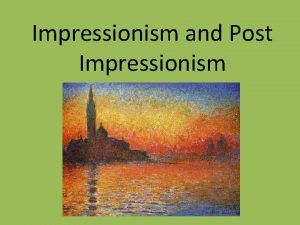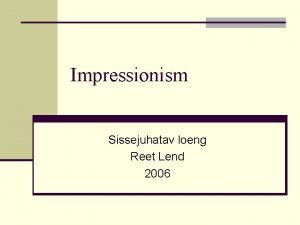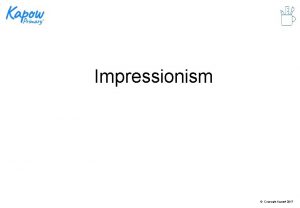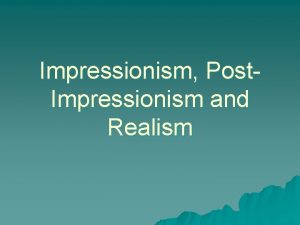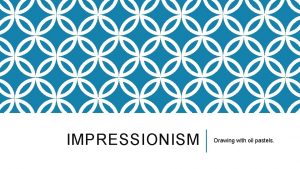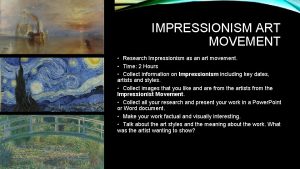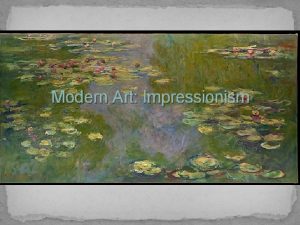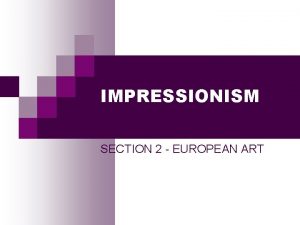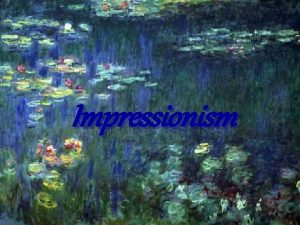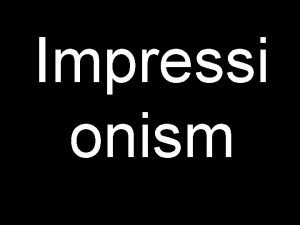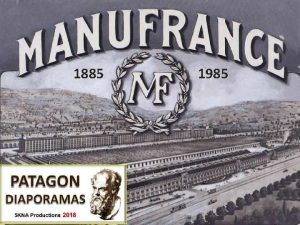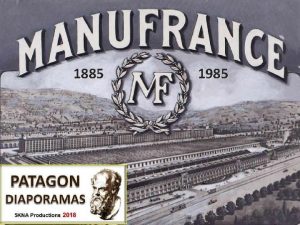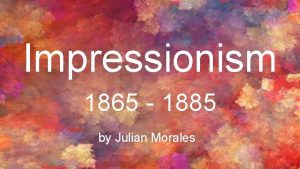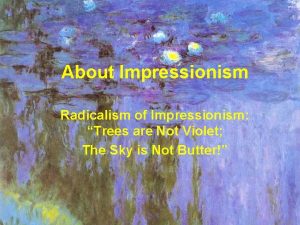Art History Impressionism 1856 1885 v Impressionism is
































- Slides: 32

Art History Impressionism (1856 -1885)

v Impressionism is a light, spontaneous manner of painting which began in France as a reaction against the restrictions and conventions of the dominant Academic art. v. Concerned with capturing light and a fleeting moment in time. v. Artists used small strokes to simulate actual reflected light. v. First group of artists to paint outside.

Royal Academies of Art in France and England The Salon & THE ACADEMY Up to this time the arts were in a type of control by the Academy that was taught at the E’cole des Beaux-Arts in Paris. The academies had a virtual monopoly on public taste and official patronage.

Brief overview of the painters needs to meet for the Academy: • Respect for the “hierarchy of genres”: 1 st: History painting with religious, mythological or historical subjects 2 nd : Scenes of everyday life 3 rd : Portraits 4 th : Landscapes 5 th : Still life • Support the prevalence of drawing over color. • Prefer the workshop to the open air • Make “finished” pieces • Imitate the elders, imitate nature

What you may find at the Academy E’cole des Beaux. Arts in Paris! Jean-Léon Gerôme (1824 -1904) The Death of Caesar (1859 -67) Figure painting class: Photographed late 1800 s at the E’cole des Beaux-Arts in Paris. Émile Munier (1840 -1895) The Cherry Tree, 1890

In the late nineteenth and early twentieth centuries, academies - and their "academic" style - became focuses of dissent among many modern artists seeking to develop new styles. April 15, 1874, The first of eight exhibitions for a group of artists opened in Paris. The artists that exhibited their works were called “rebels”, “intransigents”, “the Japanese painters” and the “actualists”. The exhibiting artists were rejected by the Salon Juries. (The Academy) They formed a Cooperative Society of Artists-Painters. Thirty artists showed their work at that time, including Monet, Renoir, Degas and Pissarro.

The term Impressionist was first used by the art critic Louis Leroy in his review of the 1874 group. When Leroy saw Claude Monet’s painting, “Impression, Sunrise” (below), he remarked: “What is this canvas trying to say? Impression, Sunrise. Impression- I was certain of it. I kept telling myself that since I was impressed there had to be some impression in it. What freedom, what ease of workmanship. Wallpaper in its embryonic stage is more finished that painting. ” The term impressionists quickly gained favor with the public. It was also accepted by the artists themselves. Although the artists did not adhere to one set of practices and were a diverse group in style and temperament. They were unified primarily by their spirit of independence and rebellion.

Interesting facts: The Impressionists were branded socialists, anarchists and dangerous revolutionaries. They were deeply misunderstood. With difficulty Richard Marx managed to include them in the Universal Exposition (World’s Fair) of 1900. When President Loubet arrived at the hall he was greeted by Gerome, who barred his entrance, exclaiming, “Don’t go in, Mr. President, for there stands the dishonor of France. ” To this mediocre painter, ” Manet was a scribbler, Monet a fraud and Renoir, Pissarro, Sisley…were actual criminals who were corrupting influences on a generation of young artists.

The public, at first hated the paintings. But the tide was turning. Gradually they came to believe that the Impressionists had captured a fresh and original vision. The art critics of that time, continued to disapprove calling the paintings unfinished sketches.

Innovations! Development of Photography The history of photography commenced with the invention and development of the camera and the creation of permanent images starting with Thomas Wedgwood in 1790 and culminating in the work of the French inventor Joseph Nicéphore Niépce in 1826. Impressionist artists felt the new technology of Photography was ruining the art of painting. They felt the need to create a new style of painting in which accurate rendering of the subject was not the main focus. Nicéphore Niépce's earliest surviving camera photograph, circa 1826: View from the Window at Le Gras (Saint-Loup-de-Varennes, France)

Tubed Paints! The availability of new pigments and tubed paints made it easier for artists to paint outdoors.

The Influence of Japanese Art In 1853, Commodore Matthew Perry of the U. S. Navy lead a fleet of frigates to Edo, Japan, where he threatened to open fire upon the town if Japan did not agree to a trade agreement with the U. S. (it was a “closed country” that did not trade with Europe/U. S. ) Once trade begun, woodblock prints made by Japanese artist’s such as Hokusai, made their way into the United States and Europe, where they were eagerly collected by artists.

Ways in which European art was influenced by the newly available Japanese woodblock prints: • • Asymmetry of compositions Dramatic cropping of image/picture plane Use of flat areas of color/pattern. Less traditional modeling Leaving large areas “empty” in a composition. Edgar Degas ‘Seated Woman Combing Her Hair’ Claude Monet ‘Waterlilies and Japanese Bridge', 1899 Hiroshige, ‘Gion Shrine in the Snow’ Henri Riviere, ‘La Tour en construction, vue de Trocadero’

• (based on scientific and medical discoveries) Light is the source of our experience of color – white light is made up of colored light. • • Shadows are not black/grey but composed of colors modified by reflections & other conditions. • • Local color (the actual color of an object) is modified by the quality of the light & reflections from other objects. Two complementary colors in small amounts placed next to each other blend in the eye to look like neutral tones. Juxtaposition of colors on canvas for the eye to fuse at a distance produces a more intense hue then mixing them

Characteristics of painting include: Rendering the visual world as it appears to the eye, not as it actually exists. Capturing a quick, spontaneous “impression” of an image: Optical sensations. • Visible brushstrokes • Light Colors • Emphasis on Light and the changing qualities of it • Ordinary Subject Matter • Unusual Visual Angles • Open Compositions

• Everyday life • Landscape painting • Countryside and seaside: often focus on modern life in suburban scenes • Bourgeoisie (ˌbu (r)zh-ˌwä-ˈzē) at leisure (sailing, café life, modern entertainment) • Cityscapes – especially Paris

In paintings made en plein air (outdoors), shadows are boldly painted with the blue of the sky as it is reflected onto surfaces, giving a sense of freshness and openness that was not captured in painting previously. (Blue shadows on snow inspired the technique. )

Visible Brushstrokes

Light Colors


Claude Monet painted more than thirty views of Rouen Cathedral! Moving from one canvas to another as the day progressed, Monet painted the facade with highly textured brushstrokes that both convey the aspect of sculpted stone and make the atmosphere and light palpable.

Claude Monet: Lily ponds & Gardens Auguste Renoir: Edgar Degas: People Outdoors Dancers and Theater Camille Pissarro: Cities and Streets Alfred Sisley: Rivers and Landscapes Mary Cassatt: Mothers and Children

Claude Monet was a founder of French impressionist painting (often called “The Father of Impressionism”, and the most consistent and prolific painter of the movement's philosophy. In the latter half of his life, Monet bought house in Giverny (rural France), where he constructed a large, lush garden in which he painted.

(1830 – 1903) Many of Pissarro’s painting depict where urban meets nature. He focused on using lighter colors and loose, short, choppy brushstrokes. Instead of depicting the passing of light, Pissarro sought to capture a spontaneous “snapshot” of a moment, influenced by the aesthetic of photography.

Mary Cassatt Self-Portrait • American-born artist that studied in Pennsylvania, then moved with her sister to France. • Became friends with Edgar Degas who became her mentor. • Subjects are mainly of domestic scenes: women and children • Paintings often show quiet moments between mother and child. • Strong sense of translucency in the skin tones of her figures.

EDGAR DEGAS • Instead of painting outdoors, Degas painted in a studio from sketches and photographs in both oil and pastel. • Degas's only showing of sculpture during his life took place in 1881 when he exhibited The Little Dancer of Fourteen Years, only shown again in 1920; the rest of the sculptural works remained private until a subsequent exhibition in 1918. • Subjects: the racetrack, the music hall, the ballet/opera, and series of bathing women. Portrait of Mary Cassatt

was a French sculptor. Although Rodin is generally considered the predecessor of modern sculpture, he did not set out to rebel against the past. He was schooled traditionally, took a craftsman-like approach to his work, and desired academic recognition, although he was never accepted into Paris's foremost school of art. • His work is considered Impressionist because of the rough surfaces and the multiplicity of plans. • In Rodin’s opinion, beauty in art consisted of a truly depiction of the internal state and for achieving that aim he used a certain distort of the anatomy.

Renoir was an Academy trained figure painter, and even after he embraced Impressionism, he still focused on figures. He glamorized the working-class clientele of the dance hall by placing his artist friends and their models in the midst. • His work is characterized by a richness of feeling and a warmth of response to the world and to the people in it. • His early works were typically Impressionist snapshots of real life, full of sparkling color and light. By the mid-1880 s, however, he had broken with the movement to apply a more disciplined, formal technique to portraits and figure paintings, particularly of women. • Renoir was so passionate about painting that he even continued when he was old and suffering from severe arthritis. Renoir then painted with the brush tied to his wrists.

The Impressionists sought to paint everyday life (like the Realists), but they also tried to show its elusive impermanence. Later 1800 s in France saw continued increases in urbanization, industrialization, secularism (from Darwin), Marxism. Modernism: The combination of rapid technological changes and exposure to a variety of cultures led to an acute sense in Western cultures of the world’s impermanence. Modernist artists seek to capture the images and sensibilities of their age, but modernism is more than just an attempt to capture the real world (like with the Realists) – Modernists also critically examine the principles of the art itself. Modernist artists (of which Impressionists are a subgroup) called attention to the surface of the painting, and to the painting as an object itself.

Impressionism became the birth of Modern Art. All of the major art movements which would follow, including Post Impressionism, Fauvism, Cubism, Surrealism, Abstract Expressionism and Pop Art owe their beginnings to Impressionism

How did the term “Impressionism” come about? What are 2 innovations that effected Impressionism? What type of art were the Impressionist’s influenced by?

What were typical Impressionist subject matter? What does the term plein air mean? Name some Impressionist artists. Which one was considered the “Father of Impressionism”?
 Traits of impressionism
Traits of impressionism How did the term impressionism originate
How did the term impressionism originate Symbolism vs impressionism
Symbolism vs impressionism July 10 1856
July 10 1856 British rule 1765 to 1836
British rule 1765 to 1836 Frederick taylor (1856-1915)
Frederick taylor (1856-1915) Smiljan 1856
Smiljan 1856 Smiljan 1856
Smiljan 1856 Dr sigmund freud
Dr sigmund freud Freud uuu
Freud uuu 1856
1856 Autoportrait berthe morisot
Autoportrait berthe morisot Britan
Britan Seyreyledim eşkali hayatı şiiri
Seyreyledim eşkali hayatı şiiri Te deseo de victor hugo
Te deseo de victor hugo Victor hugo les femmes sont sur la terre
Victor hugo les femmes sont sur la terre Un deseo victor hugo
Un deseo victor hugo Ebbinghaus 1885
Ebbinghaus 1885 7 octobre 1885
7 octobre 1885 Benz 1885
Benz 1885 Realism and impressionism art
Realism and impressionism art Romanticism vs impressionism
Romanticism vs impressionism Looseness of association
Looseness of association Post impressionism characteristics
Post impressionism characteristics La mer impressionism or expressionism
La mer impressionism or expressionism What is impressionism and expressionism
What is impressionism and expressionism Impressionism characteristics
Impressionism characteristics Impressionism 1867-1886
Impressionism 1867-1886 Impressionism vocabulary
Impressionism vocabulary Characteristics of post-impressionism
Characteristics of post-impressionism Post impressionism slideshare
Post impressionism slideshare Impressionism muusikas
Impressionism muusikas Regionalism
Regionalism




